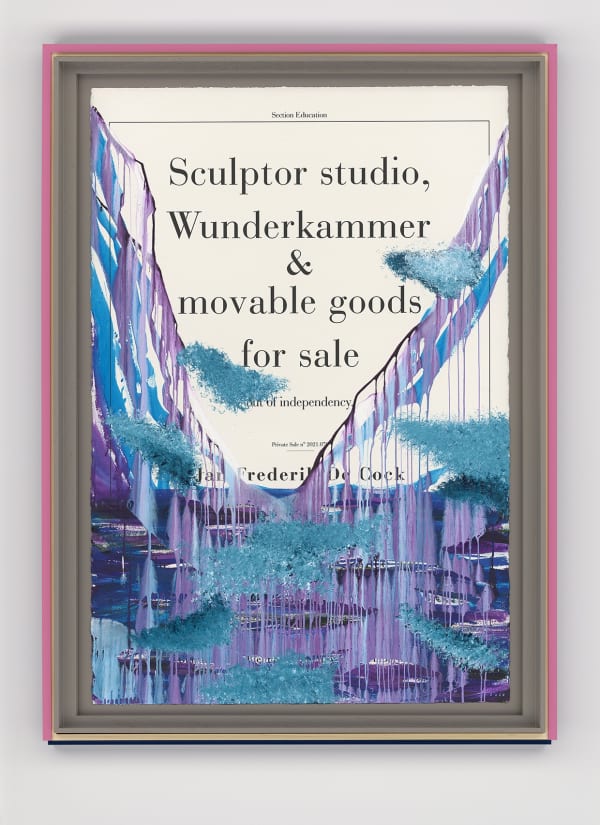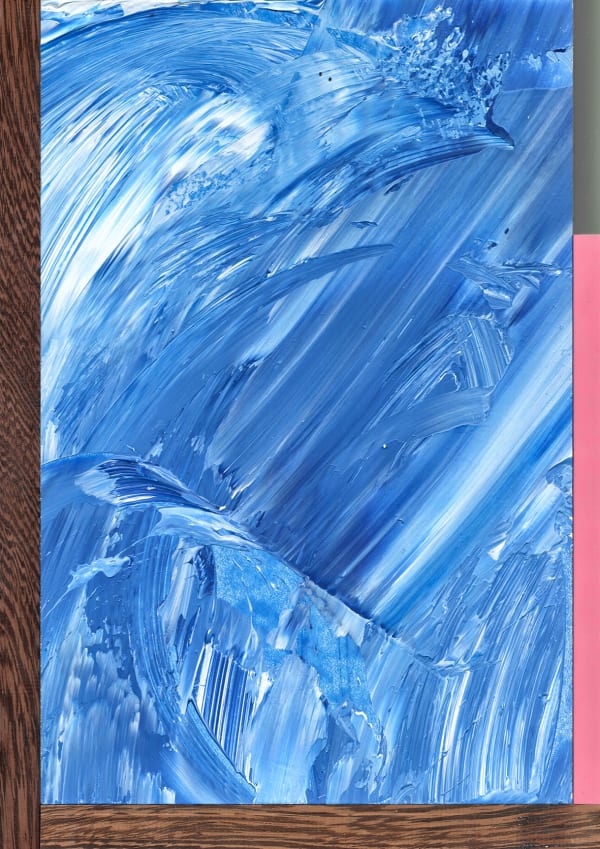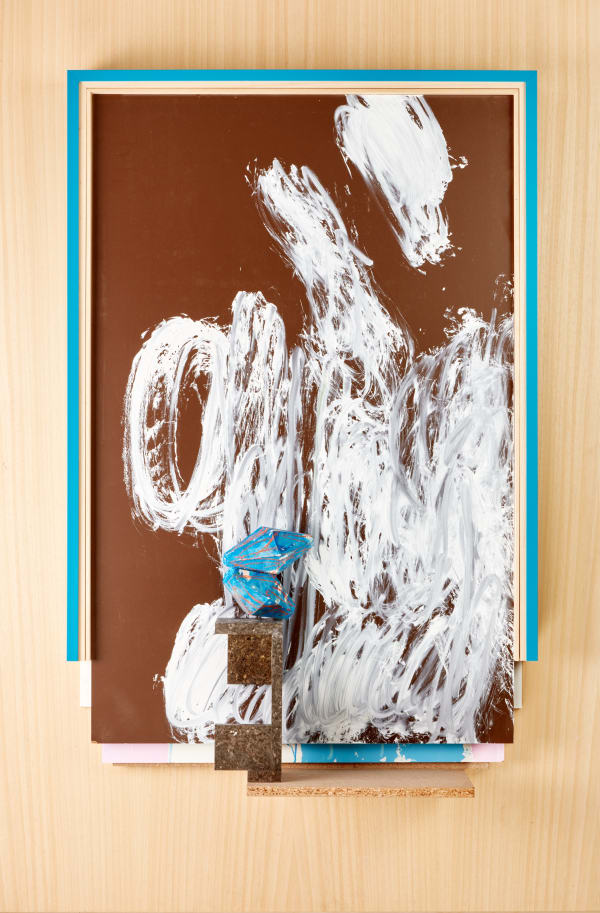Art Chronic, Art Criticism, Art Theory
JAN FREDERIK DE COCK’S
TRADITIONAL
CONTEMPORARY ART
At the beginning of the 21st century, Jan De Cock is expressing an innovative vision of contemporary art. Today, contemporary art is traditional. The time of breaking with tradition is over, now that the break itself has become a tradition, and has produced, in the hands of the young man, Jan De Cock, a synthesis of modernism and classical art in the form of monumental, handmade 'Denkmal' installations in fibreboard with strong photographic, architectural, cinematic, sculptural and performative qualities. Each temporary monument is an organism integrating like a small cathedral into the existing indoor and outdoor space and reflecting light, thoughts and history. Now, twenty years later in Bruges, De Cock is adding abstract-lyrical Alpine landscapes and Saint Sebastian faces in clay to his "traditional contemporary art", which, on the idea of rebirth, allow the cheerful light of the clear Alpine sky to shine. The works are the result of the Flemish-Italian revelation of an artist in the best, flourishing tradition of Belgian pictorial scepticism.
1. CHRONIC.
On a dark Thursday evening in January I took the train to Bruges, on my way to 'The Bruges Art Institute' the new initiative of Jan De Cock. The invitation I had received at the end of the summer made me wonder. Jan De Cock back in Belgium? And back with a school? The invitation and an interview in Knack, which could have helped me a bit on my way, made me feel wary. The 'grand opening' of the 'master sculptor', who once again proved with boastful arguments (the Moma!, the Tate!...) and other forms of self-congratulation that he had not abandoned his cocky behaviour in Italy, did not immediately arouse my enthusiasm.
Until, on an Antwerp Sunday morning in a coffee bar, I saw the photographs of his new studio in Bruges and his new landscape paintings and was eager to head off to Bruges in order to see the new pictures that made such a powerful impression on me in “De Tijd” magazine and that could still win me over. And they did. And how, but first some brief remarks about Bruges.
I have always been surprised that in the family novel of my life I kept seeing Bruges as a cheerful city: my father had been admitted to a psychiatric institution there in the 1980s, as a result of which my father was absent during almost the whole period of my primary education. The first years he stayed in Rustenburg in Bruges we went to visit him twice a week. No matter how much that depression weighed on my young life like an oppressive dark cloud, all the trips together with my depressed father in Bruges never gave the impression of the dead city it had become with Bruges-la-Morte in the imagination of the fin-de-siècle.
Was it the zest for life of my mother in saying 'we will make a trip out of it'? Or was it mainly the light and sky that are of such a clarity you cannot find in Ghent, Brussels or Antwerp? Probably both, but once again it is the light and sky of Bruges filling me with joy when I walk out of the station on 15 January into the darkness: in Bruges you can feel the proximity of the sea. You can almost smell the sea there and it upgrades the cheerful light that is further enhanced by the canal along which the new Bruges art institute of Jan De Cock is located. When, at the end of the evening, we are standing together at the Spinolarei to say goodbye, we agree: the bright, cheerful Bruges light really stimulates the imagination.
And it shouldn't surprise us that it's just here that Jan De Cock, inspired by the Italian Alpine landscape, has started making his new landscape paintings. Just like Koen van den Broek could only paint the Californian desert light when he was in 'Cloudy Old Antwerp', or Thierry De Cordier could capture the northern melancholy of the Flemish landscape in countless paintings when he lived in the Auvergne, Jan De Cock began to paint his Italian landscapes in abundance when he returned to Flanders.
2. CRITICISM.
To those who are somehow acquainted with Jan De Cock's work, the step he is now taking artistically is really surprising. We know the artist as a builder of installations in fibreboard and as a sculptor of hybrid objects. Not as a painter. Let alone as a landscape painter of large, colourful canvases, whose dripping traces of paint are most reminiscent of the abstract works in multiple, still wet layers of paint intertwined with a ruler by Gerhard Richter.
De Cock also works with different, overlapping layers of colour, but the paint is more runny, dripping over the canvas, or, as in the case of Marlène Dumas or Hellen Franktaler with her soak-stain technique, flowing over the canvas with a swaying technique and - despite the high degree of abstraction - the Italian mountain peaks and clouds still remain recognizable.
The canvases themselves are large (easily 2 meters high and one and a half meters wide), voluminous (at least 10 centimeters thick) and often conceived as a triptych, in which various faces are placed side by side. De Cock has proclaimed himself a 'Master', but presumably in the collaboration with the landscape painter Jean-Marie Bytebier the roles have - temporarily - been reversed. De Cock has followed a master class in landscape painting with Bytebier, but he has turned it into something personal. Bytebier uses a wide brush without handle, De Cock lets his paint drip more and has incorporated his camera eye and spatial hands in his landscape images.
All the landscapes I saw that Monday at the Bruges Art Institute have astonished me. And even more than with Richter, the paintings seemed like they wanted to sing to me of the power of natural beauty, with the seemingly unnatural palette of colours. Like those of the currently greatest lyrical contemporary landscape painter, David Hockney. They are abstract-lyrical Italian landscapes, painted by a Flemish Belgian. As a result, the ambition to breathe new life into these two epicentres of the European Renaissance today seems to be based less on boast than I thought. More about this in the theoretical part, first something about that other turnaround.
The second major artistic change in the oeuvre of the artist who is now signing his work with Jan Frederik De Cock are the figurative sculptures that appear in his abstract hybrid sculptures. They are large faces modelled in clay, inspired by a Saint Sebastian motif, of which at least one face with hollow eyes and open mouth seemed to release the same 'Scream' as in the iconic work of the same name by Edvard Munch.
The modernist and postmodernist De Cock is adding an existential and expressionist element to a hybrid sculpture (wood/ceramic/paint/table), in which all the frames are the physical translation of the different camera angles in a film, and in doing so he once again comes very close to Munch: Munch is not only the spontaneous painter of the loose brushwork to represent the nervous state of himself and his time, but also the artist of the foreshortening. This foreshortening is a visual element that is placed at the very front of the picture in order to hit the viewer in the face like a punch. Physical pain has not been a theme in Jan De Cock's work before, but in J. Frederik D.C.'s work it now is.
The formalist installation builder/sculptor has thus suddenly become a figurative painter and sculptor. A break and the tradition of the break are out of the question. His landscape paintings fit seamlessly with the late water lily paintings by Monet from Giverny, in which his gardens form a perfect osmosis in the reflection of the sky in the water. De Cock is also the artist who theorizes and historicizes in his art and whose mission is to reinterpret the concept of 'tradition'. Not only the city (Bruges), the stately building and leaving the 'white cube' for the old salon point to this return to a bourgeois form of tradition, but above all his art itself.
3. THEORY.
Jan De Cock's work is essential in the development of Belgian visual scepticism. Belgian pictorial scepticism arose when René Magritte spoke of 'The Betrayal of Images' (...) and Marcel Broodthaers concluded that Magritte had cursed the images. As a result, the visual artists found themselves in the paradoxical position of no longer being able to trust the images due to which they looked for a way out in making visual art with words and objects. And to make things even more difficult, Broodthaers chooses to combat conceptual art with his conceptual art. The mould in the 'moule' is empty: art has been pulled out and all that remains are the frames of art. The authority of institutional power has only become larger since it shows ordinary things as art instead of a handcrafted, recognizable work of art. In order to bypass Broodthaers' double paradox and overcome the impasse, Jan De Cock, as an artist, began to commemorate 'the mould' in the 'moule' in his 'Denk-mal' series by turning his wooden frames into camera frames in the 'Denkmal' installations: whoever moved through his monumental installations as a spectator got the feeling that he or she was looking at the world through the frame of a camera. Broodthaers' 'moule' became the 'mould' with De Cock and instead of the disappearance of art as soon as the images were replaced by words and things, images reappeared in De Cock's wooden camera frames. De Cock found a way out of the impasse and, also via Broodthaers, appropriated the right to institutionalize art in an unconventional way by playing museum director himself and thus muzzling the powerful museum management (The Book Tower in Ghent and The Tate Modern). De Cock may boast of his artistry in a dubious way by putting an impressive list of important Western institutions on his resume, but in essence his art does not deviate from the radical democratic dream that the power to proclaim something to be great art or not lies in the hands of each individual spectator.
The 'Denkmal' series formed a new link in the development of Belgian pictorial scepticism and institutional anarchism. Within the project of the radical freedom of contemporary art in which 'anyone can be an artist' and 'anyone can make art with anything' (Thierry de Duve), he also devised a normative form for the art of the 21st century.
The moment the avant-garde definitely prevails over academic art, the freedom has become so great that it becomes even more difficult to make art without the knowledge of tradition itself. From a philosophical point of view, there is no longer a tradition offering the artist a fixed arsenal of subjects (religion, mythology, history, politics...), or prescribing a material or style. This means that every individual artist is now free to choose his own material, style and technique. (The paralysis that may be caused by this manifests itself among art students, who often say that they get stuck: there is no grip anymore, the freedom is total, while critical teachers are ready to pass a harsh judgment without clear guidelines).
Within that ideal of complete freedom, De Cock was one of the few artists who managed to formulate a new paradigm at the beginning of the 21st century. With an art form indebted to minimalist modernism in particular and the 20th century avant-garde in general (industrial materials, geometric forms, modular construction, spatial-architectural functioning, photographic and performative qualities...), the 'Denkmal' series expressed that contemporary art had entered a traditional phase.
No longer 'the tradition of the break', the struggle between the different generations or the introduction of new materials, but historical continuity and building on a tradition became De Cock's motto, which could also be used as a critical instrument to weigh against other art in the 21st century. Despite the progressive self-image of the contemporary art world, art in the 21st century has become traditional. There are no breaches, formal innovations or censures of content any longer. There is traditional contemporary art, at best, or contemporary academism, at worst.
In this sense, there is therefore no break in De Cock's work since the installation builder Jan Frederik De Cock now has become a landscape painter and figurative sculptor too: the camera frame continues to live in the different angles from which the Italian mountains are painted, the Saint Sebastian figures fit seamlessly into the hybrid sculptures and are also interrelated in the Gesamtkunstwerk that has become the studio of JDC, because there is always an alternative too for the cold art rooms of the white cube.
On that cold Thursday evening in Bruges we did not only have a warm encounter because of the social contact and the revelation of the landscape paintings and screaming heads in clay, but also because of the innovative interpretation of the ‘Wunderkammer’ in the Bruges Art Institute. Despite all the political world dramas out there, Jan Frederik De Cock's new work is predominant within the cheerful Bruges light and the refreshing Italian mountain air. Even the suffering of his Saint Sebastian figures is depicted in an enlightened state. Anyone who does not stumble over the transience of De Cock's grandiloquence, but can look at his art with an open mind, awaits a rebirth.
Jeroen Laureyns of the “Agentschap voor Geestelijke Gastarbeid”, the Belgian Section. Ghent-Antwerp, 11 March 2020





